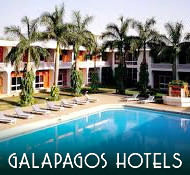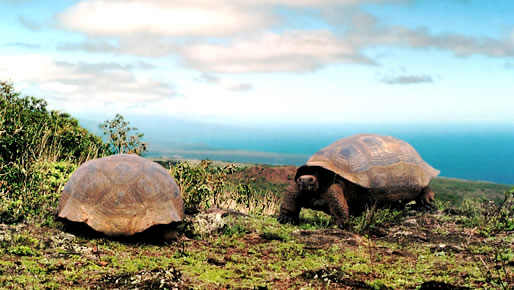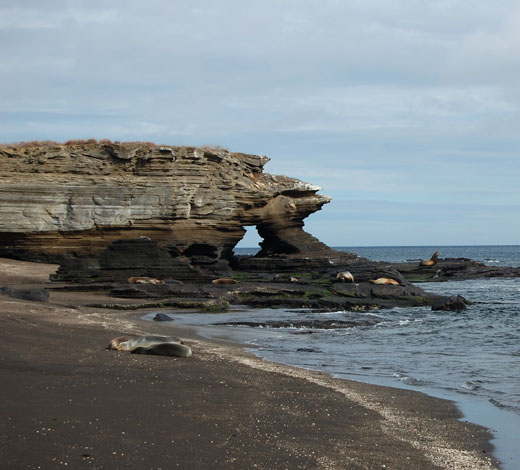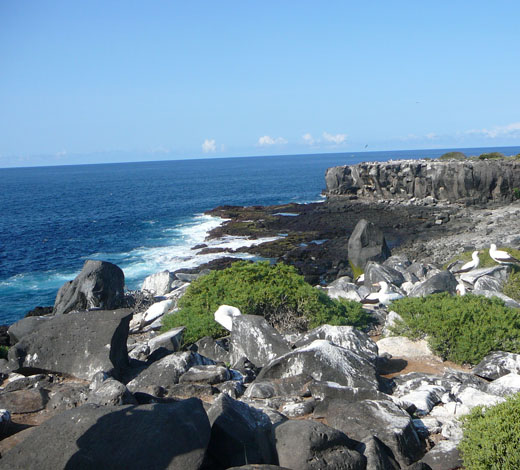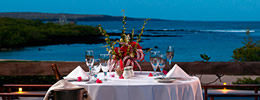Galapagos 8 days cruise
Toll free in the USA & CANADA: 1 800-704-2915 - Worldwide
The flight from Quito (via Guayaquil) to the Galapagos is approximately 2 ½ hours on a Airbus 320. Upon arrival at Baltra, you will pass through an airport inspection point to insure that no foreign plants or animals are introduced to the islands and to pay the park entrance fee of $100. Guides will meet you, collect your luggage and escort you on the short bus ride to the harbour. Motorized rafts, called ‘Pangas' will transport you to the M/V Eclipse and our crew will welcome you onboard. After departure and lunch, the first island visit is made.
Saturday Afternoon: Santa Cruz (Indefatigable) Island—Las Bachas Beach or Cerro DragonLas Bachas is a white sandy beach that is a major egg-laying site for sea turtles; Las Bachas in fact refers to the indentations left in the sand by egg laying turtles and departing hatchlings. On shore you will see marine iguanas, and, in the lagoon, flamingos are common. A newer visitor's site, Dragon Hill offers a brackish water lagoon, where flamingoes, common stilts, pintail ducks and other species of birds come to feed. There is a short walk to the hill, which rewards you with a great view and a nesting site of iguanas
Day 2. Sunday Morning: Santiago (San Salvador, James) Island—James BayThis island has several sites to visit at the western end of James' Bay. Puerto Egas with its black sand beaches was the site of a small salt mining industry in the 1960s and a hike inland to the salt crater is an excellent opportunity to sight land birds such as finches, doves, and hawks. A walk down the rugged shoreline, especially at low tide, will turn up many marine species such as iguanas basking on the rocks and sea lions lazing in the tide pools. At the end of the trail there is a series of grottos or sea caves where fur seals and night herons are found resting on the shady ledges. Just north of James' Bay is Buccaneer Cove, a particularly scenic area of steep cliffs and dark beaches.
Sunday Afternoon: Bartolome (Bartholomew) IslandBartolome is a small island that has beautiful white sand beaches, luxuriant green mangroves and a colony of penguins. Activities will include swimming and snorkeling and a climb to the summit of the island for one of the most breathtaking views in all the Galapagos. From the summit you will have the best view of the often-photographed Pinnacle.
Day 3. Monday Morning: Tower (Genovesa) Island—Darwin Bay BeachTower is a collapsed volcano and ships sail directly into its large breached caldera to anchor at the foot of the steep crater walls. Tower attracts vast numbers of pelagic seabirds that come here to nest and breed: great frigate birds, red-footed boobies, swallow-tailed gulls and storm petrels. A trail leads from a coral beach past tidal lagoons where lava gulls and yellow-crowned night herons are seen, then along the low shrubs populated by frigates and boobies, and eventually to a cliff edge where seabirds soar.
Monday Afternoon: Tower (Genovesa) Island—Prince Philip’s StepsA second trail called Prince Philip Steps, leads to an open area for masked boobies, frigates, and red-footed boobies. At the end of this trail are thousands of band-rumped storm petrels at the cliff's edge, where they nest in crevices. Short-eared owls can sometimes be seen here, hunting the storm petrels during daylight hours.
Day 4. Tuesday Morning: Fernandina (Narborough) Island—Punta EspinosaFernandina is the youngest and most active volcano in the Galapagos with eruptions taking place every few years. The flat lava of Punta Espinosa offers a stark and barren landscape, but here flightless cormorants build their nests on the point, sea lions sprawl on the beach or play in the tide pools and marine iguanas dot the sand.
Tuesday Afternoon: Isabela (Albemarle) Island—Tagus CoveOn the towering cliffs of Tagus Cove, 19th and early 20th century ships' graffiti can be seen. After hiking beyond Darwin Lake, a saltwater lagoon above sea level, you will be rewarded with extraordinary views of Darwin and Wolf volcanoes.
Day 5. Wednesday Morning: Isabela (Albemarle) Island—Urbina BayUrbina Bay is an easy wet landing on a gentle sloping beach. This area is very interesting in that it is a perfect example of the geological activities of the islands. In 1954 over 3 miles (5 kilometers) of the marine reef at the edge of the shore was uplifted by 13 feet (4 meters).
Wednesday Afternoon: Isabela (Albemarle) Island—Elizabeth BayAt Elizabeth Bay enjoy a panga ride through the mangrove area to see the rays, turtles, sea lions, and, circling overhead, Galapagos hawks. Colonies of penguins inhabit a rocky islet at the entrance to Elizabeth Bay.
Day 6. Thursday: Santa Cruz (Indefatigable) Island—Puerto Ayora TownSanta Cruz is the only inhabited island to be visited during this Galapagos cruise. Puerto Ayora, with a population of about 10,000 people is the location of the Charles Darwin Research Station, world famous for its tortoise breeding programs. After touring the Station, journey by bus into the highlands to Los Gemelos, the two deep pit craters situated in the Scalesia forest with lots of interesting bird life. Go for a walk through the giant lava tubes; visit the Tortoise Reserve to search for giant tortoises in their natural surroundings. There will be some free time to explore the town of Puerto Ayora on your own.
Day 7. Friday Morning: Hood (Española) Island—Gardner BayOne of the oldest of the islands, Hood is small and flat with no visible volcanic crater or vent. Gardner Bay is on the eastern shore and has a magnificent beach. This beach is frequented by a transient colony of sea lions, and is a major nesting site for marine turtles. Around the small islets nearby, snorkelers will find lots of fish and sometimes turtles and sharks. On a trail leading to the western tip of the island you'll pass the only nesting sites in the Galapagos of the waved albatross, huge birds with a wingspan over 6-feet in length. These huge birds nest here from April to December and represent the majority of the world's population of this species.
Friday Afternoon: Hood (Española) Island—Punta SuarezPunta Suarez is one of the most outstanding wildlife areas of the archipelago, with a long list of species found along its cliffs and sand or pebble beaches. In addition to five species of nesting seabirds there are the curious and bold Hood Island mockingbirds, Galapagos doves and Galapagos hawks. Several types of reptiles, including the brilliantly colored marine iguana and the oversized lava lizard, are unique to this island. When heavy swells are running, Punta Suarez is also the site of a spectacular blowhole, with thundering spray shooting 30 yards into the air.
Day 8. Saturday Morning: Santa Cruz (Indefatigable) Island—Black Turtle CoveThe panga will take you into a tidal lagoon to see three kinds of mangrove plants, red, white and black. White-tipped sharks, spotted rays, mustard rays and Pacific marine turtles frequent the waters here. Return to the airport for your return flight back to the mainland.

